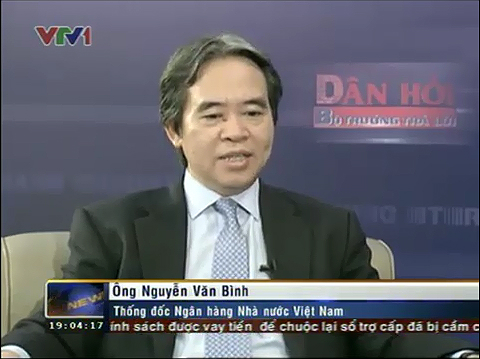People blame the central bank for letting the local gold price rise ever higher in comparison to its international counterpart, as they have misunderstood the central bank’s gold management policies, said the governor of the State Bank of Vietnam.
Stabilizing the gold market doesn’t necessarily mean that the price gap between the local and international price should be narrowed, SBV governor Nguyen Van Binh said on a recent TV program aired on national broadcaster Vietnam Television.
The SBV’s degree No.24 on management of the local gold market set a target of stabilizing the market only, not stabilizing the gold price by closing down the gap, he said on “The people ask- Ministers reply” program.
Stabilizing the market here also means stabilizing the local gold price at a certain level, disregarding the world gold price trend.
That comes from monetary theory as well as the practical situation in Vietnam in the recent past.
The Vietnam dong has not been floated on the international foreign exchange market yet. As a result, the domestic and international foreign exchange markets are not interconnected, Binh said.
Gold, in fact, can essentially be considered a foreign currency here, because by nature Vietnam is a net gold importer.
Therefore, if the foreign exchange market is not interconnected, why should the gold market be interconnected, Binh asked.
In fact, before the release of Decree 24, fluctuations in the world gold price had been closely reflected in the local foreign exchange market, creating pressure on the dong to be devalued and destabilizing the macroeconomic situation.
But after the decree came into effect, no matter how much the global gold market fluctuated, the local foreign exchange market remained stable, and the world gold price no longer affected or impacted the local macroeconomic situation.
Stabilizing the local gold price, currently at VND42 million a tael, also helps prevent speculation by local investors, Binh said.
For example, over a three day period in the last week of April, the world gold price dropped dramatically.
Previously, immediate adjustment of the domestic prices to catch up with the world price would have created waves of speculation. As people rushed to buy gold, the foreign exchange rate would have been badly affected.
But that has not happened. As domestic prices have remained relatively stable, the motivation to speculate on gold has become less attractive, Binh explained.
Regarding the question of who will be the biggest beneficiaries from the gold management policy, Binh said they are the normal people, especially gold sellers, as they can sell at higher than the world price.
Previously, without the gold management decree, private firms, economic organizations importing gold for reselling or gold smugglers were the biggest beneficiaries, and they reaped profits from gold price fluctuations.
But now all gold trading activities undertaken by the state are meant to ensure that the entire difference between the domestic price and the world price of gold will be channeled into the state budget to reinvest in the economy and implement social welfare projects, Binh added.
|
The government and the National Assembly earlier this year assigned SBV to narrow the gap between the international and local gold price to an acceptable rate after the price gap shot up to VND3-3.5 million a tael (1tael = 1.2 ounces). Binh, in a televised National Assembly Q&A session late last year, said the acceptable price gap between international and local gold should be VND400,000 a tael. |


















































